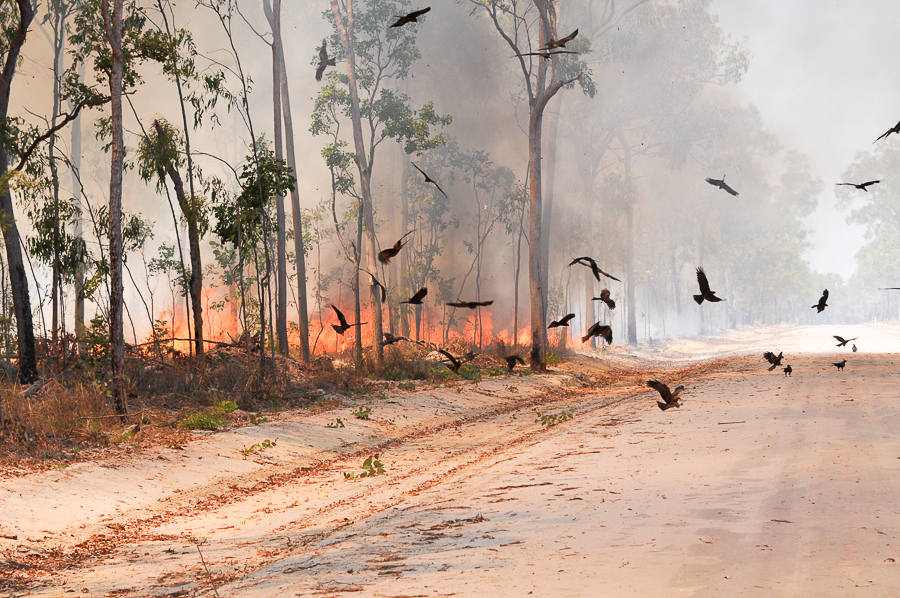
Indigenous knowledge of birds spreading fires rediscovered in Australia
The type of environment, climate, vegetation and human activity all play a role in how fires spread. In Australia’s deserts, a new factor must be considered: birds.
The indigenous peoples of Australia had myths and tales of raptors starting fires, and recent ethnographic work has shown birds using fire is a real possibility. These hawks are known as fire-foragers, and feed on animals fleeing fires or the remains of animals caught in fires. These ‘firehawks’ supposedly grab burning sticks to drop them elsewhere. It is theorized that the purpose of starting fires elsewhere is to feast on the numerous small prey that collectively flee the fire. Their direct association with dangerous territory makes this issue difficult to document, as many people do not wish to be near wildfires.
“The birds aren’t doing things optimal for fire management and need to be taken seriously,” said Dr. Mark Bonta, a geographer at Pennsylvania State University and one of the authors of the paper published about firehawks.
The birds in question are the brown falcon (Falco berigora), whistling kite (Haliastur sphenurus), and black kite (Milvus migrans). All of these birds are common in the Australian savanna, especially the black kite, which has the nickname of “shithawk”. Although illegal, it is suspected these birds are killed as pests.
Bob Gosford, an indigenous lawyer for Australia, reached out to Bonta about the project. Previously, Bonta had done ethnobotany research in Central America on cycads and the relationship between humans and the plant.
“It [firehawks] surprised me initially, but I have a track record of finding stuff,” Bonta said. “The earth has been imperfectly explored. We know a tiny bit and most of it is probably wrong.”
Bonta helped Gosford structure interviews to get primary accounts claiming the birds were spreading the fires. Bonta later went to Australia with funding from Pennsylvania State. Most of the funds were spent on plane tickets.
“It’s still a low budget operation, it’s still exploratory,” Bonta said.
“By and large, raptors aren’t one of the groups of birds most renowned for tool use,” said Julie Cotton, the volunteer and outreach coordinator at the California Raptor Center. “[…] most of the tool use in raptors is some vultures species use rocks to help break open eggs. There are some vultures, and some eagles as well that are known to do that. But the birds most famous for tool use out there tend to be the corvids; the crows, ravens.”
While there has been no official documentation of firehawks starting fires, eyewitness accounts and blurry Youtube videos have called attention to this behavior.
“I’ve had people say I saw a cougar and then it’s like an orange housecat… I always take people’s wild sightings with a grain of salt. But if it’s a trained person, then I trust them a little bit more,” Cotton said. “[…] these people were trained people who’ve lived there, who know the different species, who work in the field, so that, to me, gives it a lot more credibility.”
The knowledge of the firehawks had been mostly reserved to the Aboriginal community and those battling wildfires. Sightings of the hawks using fire were rare, even in this setting. Although having known about birds’ abilities to use fire, Monique Borgerhoff-Mulder, a UC Davis anthropology professor who has done conservation and development projects in multiple African countries, warns against idealizing indigenous knowledge.
“There are many things science miss, many things indigenous peoples miss,” Borgerhoff-Mulder said. “Important indigenous knowledge is how to make a living in an area. Knowledge is important, but be very careful to not romanticize it.”
One future research topic on the firehawks that needs to be addressed is whether or not the birds are picking up the burning sticks on purpose. Even if the smouldering sticks are accidentally dropped by the birds, the end result of feasting on fleeing animals would be the same.
“There are so many wild animals, their response to fire is fear, they flee. It will be interesting if those birds really do have some way to put aside that, you know, evolutionary history fear of fire,” Cotton said.
Bonta is aware the team has to win over skeptics that think fire is solely reserved for humans. The team is planning on doing controlled burns in May to see if they can document the phenomenon.
Aboriginal communities and fire managers have cooperated and helped Gosford and Bonta in their fieldwork. Bonta appreciates the traction this work has gotten with only preliminary results.
“We haven’t published the best stuff,” Bonta said.
Written by: Rachel Paul — science@theaggie.org




